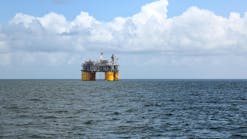FOCUS: UNCONVENTIONAL OIL & GAS: US expects tight oil production gains from Bakken, Eagle Ford
Producers report that better efficiencies are delivering higher volumes of oil from the South Texas Eagle Ford and the Bakken formation in North Dakota and Montana. Higher Bakken production comes despite reduced rig counts, which one producer attributed to a shift toward pad drilling.
Unconventional oil and gas drilling was a key topic during second-quarter earnings calls. Citing low natural gas prices, most companies said they plan little dry gas drilling during this year's second half.
Tight oil plays are contributing heavily to growing US oil production.
Wood Mackenzie Ltd. expects US tight oil output to rise to 4.2 million b/d by 2020 from 1.6 million b/d in 2012 with the Bakken and Eagle Ford primarily driving that growth.
Phani Gadde, senior analyst with WoodMac's Houston office, said, "The pace of production growth from both plays has been nothing short of phenomenal." WoodMac has outlined its tight oil forecast in recent client forums, and Gadde spoke with OGJ about the forecast.
WoodMac sees potential upside to its forecast from emerging plays such as the Utica as well as continued growth in the Eagle Ford and Bakken while operators downspace, improve technologies, and leverage efficiencies.
WoodMac forecasts that the Bakken will produce 1.3 million b/d of oil and the Eagle Ford will produce 1.3 million b/d of condensate and oil by 2020. Other plays across the Lower 48 will contribute to the anticipated 4.2 million b/d total by 2020.
These other plays include the Permian plays like the Bone Spring, Avalon, Wolfcamp, and Cline shales, which are expected to contribute 440,000 b/d by 2020.
"In the Rockies, we forecast modest production growth from the Niobrara: 90,000 b/d by 2020," Gadde said. "Then, you have the Utica and other emerging plays along with some of the smaller established plays like the Mississippian, Austin chalk, and Monterey."
On a global level, WoodMac sees US tight oil as the key emerging growth area during the next decade from non-OPEC members.
Companies outline expectations
Mark Papa, chairman and chief executive officer of EOG Resources Inc., said in early August that he sees three US horizontal oil plays as being consequential: Eagle Ford, Bakken, and Permian.
Regarding the Bakken, Papa expects EOG will continue to increase oil production in 2013 and beyond.
Given low natural gas prices, QEP Resources Inc. allocated capital to crude oil and liquids-rich gas plays, said Chuck Stanley, chairman, president, and chief executive officer of the Denver-based independent formerly known as Questar.
Continental Resources Inc. Chairman and Chief Executive Officer Harold Hamm noted during an Aug. 12 webcast that industry is moving from an exploration phase into more of a development phase in the Bakken.
"We're seeing a transition happen from people basically scurrying to take care of their leasehold commitments," Hamm said. "As it happens, we'll see pullback in the level of activity up there, we believe, and to a point that we can all control cost…. The emphasis we see across the field, operator by operator, is renewed interest in keeping those costs in line. And when everybody is scurrying around to hold leases, you do things you wouldn't do as you go through development."
Continental ran 19 operated rigs in the Bakken on Aug. 8, down from its 26 operated rigs earlier in the year. Of its latest Bakken fleet, 15 rigs worked in North Dakota and 4 in Montana. Executives said they reduced the Bakken rig count because Continental is transitioning into a development mode there.
The Oklahoma City independent added 31,057 net acres this year, bringing its Bakken leasehold to 946,248 net acres as of June 30.
"The entire industry is wrestling with cost escalation and has really chosen to focus on their own operations," said Rick Bott, Continental president and chief operating officer. On the contrary, Continental increased its interests in operated and nonoperated wells.
Bott acknowledged some cost creep. "Nonoperated wells are running $2 million higher than our operated wells, which are currently averaging $9.2 million in the North Dakota Bakken, and about $9.5 million in the Southeast Cana, Anadarko Woodford area."
The $9.2 million is Continental's average for single wells, he said, adding that an ECO-Pad individual well averages $8.4 million. ECO-Pad rigs represented about half Continental's Bakken drilling fleet in early August as Continental continued exploring and extending the limits of the Bakken-Three Forks.
In the Bakken, Continental produced 53,741 boe/d during the second quarter, up 97% compared with the same period in 2011. It participated in 154 gross (56 net) wells of which it operated 69 gross (46 net) wells in the Bakken: 62 gross (41 net) in North Dakota and 7 gross (5 net) in Montana.
Hamm said Continental continues to see strong production results from new wells in the Middle Bakken and Three Forks zones.
"In the Bakken, we improved drilling cycle times by approximately 30%; in essence, we are accomplishing more with less," Hamm said. "By yearend 2013, we expect to substantially derisk and establish production in each spacing unit at our North Dakota Bakken acreage. This will allow us to employ more ECO-Pad rigs."

Paula Dittrick | Senior Staff Writer
Paula Dittrick has covered oil and gas from Houston for more than 20 years. Starting in May 2007, she developed a health, safety, and environment beat for Oil & Gas Journal. Dittrick is familiar with the industry’s financial aspects. She also monitors issues associated with carbon sequestration and renewable energy.
Dittrick joined OGJ in February 2001. Previously, she worked for Dow Jones and United Press International. She began writing about oil and gas as UPI’s West Texas bureau chief during the 1980s. She earned a Bachelor’s of Science degree in journalism from the University of Nebraska in 1974.


